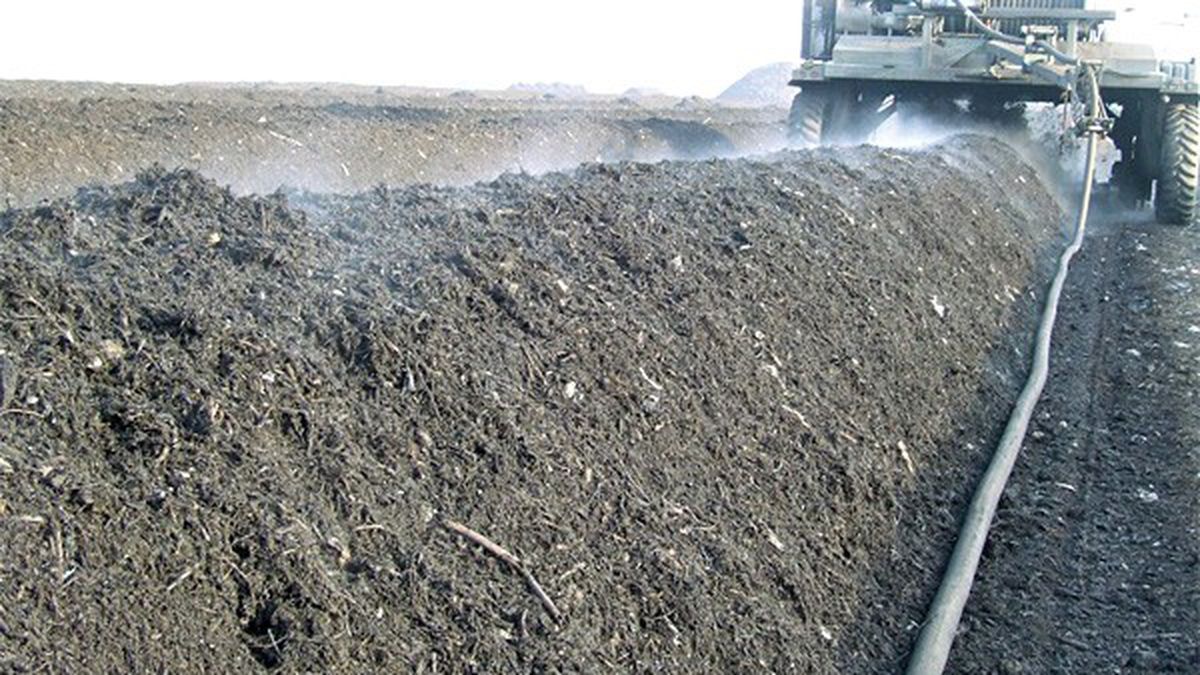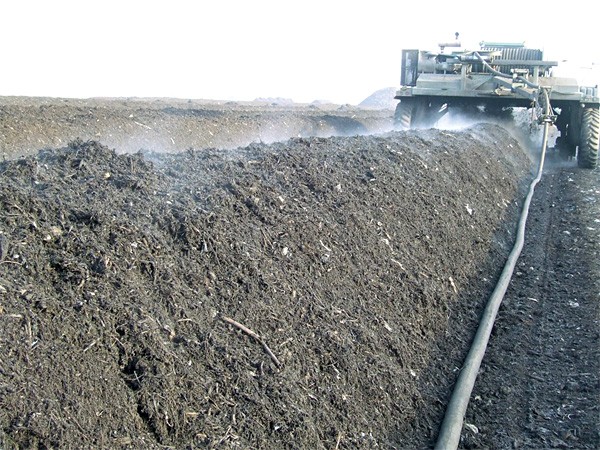About 65 miles east of the curb where you set out your green bin full of food scraps, there is a seventy-acre pile of steaming crap eagerly waiting to digest and regurgitate every last morsel. An egg toss from Modesto, the massive Grover Environmental Products composting yard collects a large portion of Alameda County’s organic leftovers, including all its food scraps, garden trimmings, and pizza boxes.
In an effort to cap the ever-rising size of its landfills, fourteen of Alameda County’s sixteen cities now encourage residents to think twice before trashing their food scraps. Berkeley is merely the latest town to fall in line, having just begun to collect residential food scraps this September. Long a green trendsetter, Berkeley was surprisingly late to this party, behind such unlikely pioneers as Fremont, Newark, and Castro Valley, the latter of which was the area’s first food-scrap recycler in 1999. This high participation rate is largely a result of StopWaste.org, a county initiative that gives cities grants to reduce their waste stream.
Berkeley officials knew that food and soiled paper products made up about one third of their residential waste — a compelling rationale for them to expand their green-bin program. In 2003 alone, an estimated 7,800 tons of residential organic waste went straight to the county landfill, according to Tania Levy, the city’s Recycling Program Coordinator.
But officials had questions about how many residents would actually participate. So they looked at the experience of their neighbors. Although Oakland, which started in 2005, has reduced a significant amount of waste, its program has grown gradually. According to Peter Slote of the city’s Public Works Department, only about one in eight Oakland residents actually tosses food scraps in their green bin — a rate roughly equal to early participation in bottle and can recycling. “There’s a perceived barrier about food-scraps recycling as inconvenient or icky,” Slote said. “They’ll come around.”
But Berkeley has jumped on the bandwagon, Levy said. In October, there were nearly 300 tons more organic waste in residential green bins than there was one year before. “I wasn’t really sure that a lot of people would participate, but apparently they are,” she said. In fact, the city will soon need to add two more trucks to sustain its voluntary, and now weekly, pickups.
Berkeley followed the example of Oakland and Albany by providing small green kitchen pails for every building of four units or less, along with an info packet and a little bag of reincarnated dinner. “We wanted to give people a gift at the beginning to encourage them to participate and also to show them what it is they’re doing — that this is the lovely stuff their food is made into,” Levy said.
The city agreed to pay Grover Environmental Products $33.50 per ton to pick up its organic waste, compared to the $70 per ton it costs to take trash to the Altamont landfill, 45 miles away. Currently, about 2,500 tons of biodegradable material is dropped off each month at Berkeley’s Gilman Street transfer station, where Grover’s trailers come daily to haul away every last banana peel. From there it goes to the compost facility.
Surrounded by agricultural lands, it is a farm of sorts — albeit one where green things turn brown. The wafting aroma of rotting food greets visitors at the gate, near where trailers are weighed and then unload, forming a small peak of organic waste. Pumpkins, chicken bones, yard trimmings, and apple cores are all visible as they prepare for their transformation.
Huge machines snarl and hurl scraps, as workers on foot and in bulldozers traverse the mound, picking out glass, plastics, and other contaminating elements. The scraps are then put through giant screens that filter out anything larger than three inches. The big chunks go through a grinder the size of an eighteen-wheeler and are then combined with the finer ingredients.
In this business, ratios are everything, explains Manager Adam Grover, whose father owns the company. Thirty parts carbon to one part nitrogen — or roughly three parts green matter to two parts shredded scraps — is the desired chemical cocktail. After about five weeks, the waste is moved from the processing area and put into windrows: fifty-yard long, five-foot high triangular rows.
“This is really where it all happens,” said Grover, navigating a pickup truck through his vast empire of waste. “If you get this wrong, you don’t get quality compost.”
At first glance, the windrows look like nice geometrically-shaped piles of crap. And that’s essentially what they are, but there is a bit more to it than that. Within each pile, billions of microorganisms are furiously eating their way through the organic matter, breaking it down in a process called aerobic respiration, and producing a fiber-rich fertilizer full of carbon and nitrogen that plants crave.
Over ten weeks, a two-story-high, insect-like monster on wheels straddles the windrows, slowly rumbling its way down each row, churning the material to provide much-needed oxygen to the microorganisms while pumping out a large quantity of water to keep the piles at about 50 percent moisture level. The diversity of organic material is so rich that no manure is necessary for enhancement.
The decomposition reaction produces a huge amount of heat, so much so, that within a day, the inside of the piles reach 150 degrees Fahrenheit and steam rises off them as if from a kettle. The piles can actually get too hot — anything over 160 degrees may disrupt the process. With the exception of large bones, logs, and putrid waste, pretty much anything biodegradable that is thrown in one of those piles will be gone in a matter of days, from sirloin steaks to watermelons.
“It’s mind-blowing,” Grover remarks, reaching his hand valiantly into a steam-filled hole in the side of a windrow. “It’s truly recycling in and out.”
Throw your potato peels in the garbage and they add to the ever-mounting landfill pile, which releases significant quantities of methane and carbon dioxide. Toss them in the compost bin and they get turned into nitrogen-rich fertilizer — black gold to farmers and landscapers, who mix it back into the soil where it enhances the growth of more organic material. It is the simplest, most natural form of recycling.
That’s not to say that the process isn’t resource-intensive. In addition to making and distributing the green bins and fuel needed to pick up the waste and truck it out here, a fair amount of energy goes into sorting through the waste and removing as many of the contaminants as possible. The less conscious people are about what they toss in their bins, the more costly and inefficient the process, Grover said. There also is a huge amount of diesel used to power the machines; the grinder alone guzzles 45 gallons an hour. And a tremendous volume of water is needed to irrigate the windrows.
Nonetheless, the yard produces huge amounts of valuable fertilizer from organic matter that would otherwise sit forever in a landfill. Grover’s business operates three composting facilities in the region. This one alone collects about 120,000 tons of waste a year and turns it into 80,000 tons of compost. And while some of that decrease is from the sorted-out contaminants, a good deal of mass is simply lost during the breakdown process, due largely to evaporation.
After two and a half months of decomposition, and sifted a final time for purity, the result is soft, rich, black compost. Grover returns up to 10 percent of Berkeley’s compost back to Berkeley, some of which is used by city landscapers. A good chunk is given to the Berkeley Gardening Collaborative, which distributes it to school and community garden projects. The rest is sold to farms, golf courses, and landscapers. Grover sells its highest-grade compost for $12 a cubic yard. This facility alone grosses about $650,000 in sales a month.
“It’s not a cash cow, but it’s a viable business,” said Grover, noting that profits, while largely nonexistent at first, have increased significantly in recent years.
















